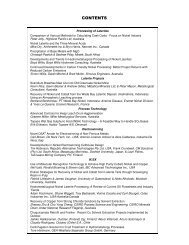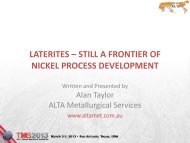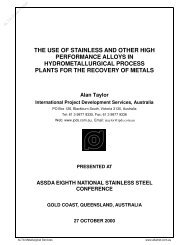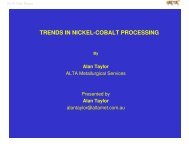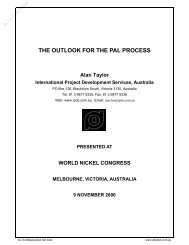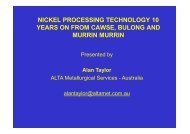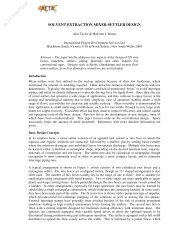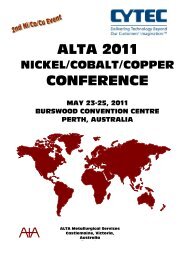what's happening in copper hydromet - ALTA Metallurgical Services
what's happening in copper hydromet - ALTA Metallurgical Services
what's happening in copper hydromet - ALTA Metallurgical Services
You also want an ePaper? Increase the reach of your titles
YUMPU automatically turns print PDFs into web optimized ePapers that Google loves.
WHAT’S HAPPENING IN COPPER HYDROMET<br />
Presented by<br />
Alan Taylor<br />
<strong>ALTA</strong> <strong>Metallurgical</strong> <strong>Services</strong>, Melbourne<br />
alantaylor@altamet.com.au<br />
AusIMM Melbourne Technical Meet<strong>in</strong>g, September 2013
INTRODUCTION<br />
Copper <strong>hydromet</strong>allurgical technology is cont<strong>in</strong>u<strong>in</strong>g to<br />
develop and expand for the treatment of <strong>copper</strong> oxide and<br />
sulphide ores and concentrates.<br />
2
KEY DRIVERS<br />
• The emergence of SX-EW as a robust, relatively low-tech,<br />
process for selectively extract<strong>in</strong>g <strong>copper</strong> from sulphuric acid<br />
leach solutions and produc<strong>in</strong>g Grade A cathode product.<br />
• The availability of extensive high grade oxide <strong>copper</strong> and<br />
<strong>copper</strong>/cobalt ore deposits <strong>in</strong> the Central African Copperbelt.<br />
• The successful large scale treatment of oxide ores by heap<br />
leach<strong>in</strong>g and secondary sulphide ores by heap bio-leach<strong>in</strong>g.<br />
• The need for an economic process for treat<strong>in</strong>g low grade and<br />
complex primary sulphide ores.<br />
• The desirability of produc<strong>in</strong>g a high grade <strong>copper</strong> product at site,<br />
especially for small, medium and remote sulphide ore m<strong>in</strong>es.<br />
•<br />
3
KEY DRIVERS (CONT.)<br />
• The need for an alternative to smelt<strong>in</strong>g for concentrates with<br />
significant levels of undesirable impurities such as arsenic.<br />
• The successful application of <strong>hydromet</strong>allurgical processes such<br />
as pressure oxidation and bio-oxidation for the treatment of gold<br />
and z<strong>in</strong>c ores and concentrates.<br />
• Increas<strong>in</strong>gly str<strong>in</strong>gent environmental regulations for smelter<br />
off-gases.<br />
4
CHALLENGES<br />
• High energy consumption of electrow<strong>in</strong>n<strong>in</strong>g from sulphate<br />
solutions<br />
• Volatility <strong>in</strong> the availability and price of elemental sulphur and<br />
sulphuric acid.<br />
• High transport cost for reagents to remote sites, especially<br />
sulphuric acid.<br />
• Slow leach<strong>in</strong>g k<strong>in</strong>etics and low recovery from primary sulphides<br />
such as chalcopyrite with sulphuric acid solutions at atmospheric<br />
temperature due to the formation of a passivation layer.<br />
• Precious metals recovery from leach residues.<br />
5
CHALLENGES (CONT.)<br />
• High cost for regenerat<strong>in</strong>g and recycl<strong>in</strong>g alternative lixiviants<br />
such as hydrochloric acid.<br />
• Unfamiliarity of m<strong>in</strong><strong>in</strong>g <strong>in</strong>dustry with alternative lixiviants.<br />
• High risk factor <strong>in</strong> the application of new technology.<br />
• Lack of skilled labour and support services at remote m<strong>in</strong>e sites.<br />
6
AREAS OF DEVELOPMENTS<br />
• A resurgence of atmospheric agitated tank sulphuric acid<br />
leach<strong>in</strong>g circuits for high grade oxide <strong>copper</strong> and <strong>copper</strong>/cobalt<br />
ores.<br />
• Application of high temperature atmospheric agitated tank acidic<br />
ferric sulphate leach<strong>in</strong>g of secondary sulphide ores.<br />
• Extension of heap bio-leach<strong>in</strong>g to low grade chalcopyrite ores.<br />
• Development of a variety of <strong>hydromet</strong> treatment processes for<br />
<strong>copper</strong> sulphide concentrates.<br />
• Developments <strong>in</strong> SX and EW.<br />
7
AGITATED TANK SULPHURIC ACID LEACHING<br />
OF OXIDE ORES<br />
• S<strong>in</strong>ce 1960s, has been largely displaced by lower cost heap<br />
leach<strong>in</strong>g.<br />
• However, there has been a recent resurgence for <strong>copper</strong> and<br />
<strong>copper</strong>/cobalt projects <strong>in</strong> the Central African Copperbelt due to:<br />
– Higher grade ores able to support higher capex and opex<br />
– Higher recovery<br />
– Short testwork program<br />
– Relatively fast ramp-up time<br />
– Reliable scale-up and lower technical risk<br />
– Need to reduce cobalt m<strong>in</strong>erals.<br />
• Numerous projects <strong>in</strong> DRC and Zambia.<br />
8
TENKE FUNGURUME FLOWSHEET, FCX, DRC<br />
(Ref: Tenke M<strong>in</strong><strong>in</strong>g Corp. presentation March 2006)<br />
9
TENKE FUNGURUME OPERATION, FCX, DRC<br />
(Ref: Freeport McMoRan conference presentation, 2009)<br />
10
AGITATED TANK ACIDIC FERRIC SULPHATE LEACHING<br />
OF SECONDARY SULPHIDE ORES<br />
• Typically applied to high grade secondary sulphide and mixed<br />
sulphide/oxide ores. (Heap bio-leach<strong>in</strong>g is commonly used for<br />
lower grade ores.)<br />
• Operations:<br />
- Sepon, MMG, Laos<br />
- Las Cruces, First Quantum, Spa<strong>in</strong><br />
- Mt Gordon, QLD, now closed.<br />
• The ferric iron level is ma<strong>in</strong>ta<strong>in</strong>ed by oxygen <strong>in</strong>jection or<br />
pressure oxidation.<br />
• Typically operates at high temperature; cool<strong>in</strong>g ahead of SX.<br />
11
SEPON FLOWSHEET, MMG, DRC<br />
(Ref: David Dreis<strong>in</strong>ger presentation, <strong>ALTA</strong> 2012)<br />
12
SEPON OPERATION, MMG, LAOS<br />
13
HEAP BIO-LEACHING OF LOW GRADE CHALCOPYRITE<br />
• There are many <strong>copper</strong> primary sulphide deposits which cannot<br />
be economically treated by conventional means due to low<br />
grade or problem impurities.<br />
• Heap leach<strong>in</strong>g us<strong>in</strong>g common iron oxidiz<strong>in</strong>g bacteria, ambient<br />
temperature and conventional techniques results <strong>in</strong> very slow<br />
leach<strong>in</strong>g rate and low recovery, due to a passivation layer.<br />
• Recovery is typically limited to about 30% <strong>in</strong> 3-5 years though<br />
there are some more reactive orebodies.<br />
• A number of organizations are undertak<strong>in</strong>g development<br />
programs <strong>in</strong>clud<strong>in</strong>g BioHeap/Western Areas, Australia; M<strong>in</strong>tek,<br />
South Africa; BacTech, Canada; GeoBiotics, USA; BHP Billiton,<br />
Chile; BioSigma (Codelco/Nippon), Chile; Rio T<strong>in</strong>to, USA.<br />
• Strategies <strong>in</strong>clude development of special bacteria cultures,<br />
maximization of operat<strong>in</strong>g temperature, and optimization of<br />
irrigation patterns and aeration rates.<br />
14
MINTEK TEST HEAP AT DAREHZARE MINE, IRAN<br />
(Ref: M<strong>in</strong>tek paper, <strong>ALTA</strong> 2007)<br />
15
HYDROMET PROCESSES FOR SULPHIDE CONCENTRATES<br />
• Numerous processes have been tested over many years but only<br />
a few have been commercialized, with limited success.<br />
• Current processes under development <strong>in</strong>volve:<br />
– medium and high temperature pressure oxidation<br />
– atmospheric tank bio-oxidation<br />
– atmospheric tank galvanic leach<strong>in</strong>g<br />
– chloride leach<strong>in</strong>g.<br />
• Of these:<br />
– high temperature pressure oxidation has been commercialized<br />
– medium temperature pressure oxidation and tank bio-oxidation<br />
have reached small scale commercial or semi-commercial level<br />
– galvanic leach<strong>in</strong>g has reached pilot plant scale<br />
– chloride leach<strong>in</strong>g has reached pilot scale (though a<br />
commercial operation has been operated <strong>in</strong> the past).<br />
16
HIGH TEMPERATURE PRESSURE OXIDATION<br />
• Uses pressure oxidation with oxygen <strong>in</strong> an autoclave at<br />
200-225°C. Copper is solubilized as sulphate, iron precipitates<br />
as hematite. Sulphur forms metal sulphates and sulphuric acid.<br />
• Solid-liquid separation is carried out <strong>in</strong> CCD thickeners and/or<br />
filters.<br />
• Copper recovery from the clarified solution is by conventional<br />
SX/EW.<br />
• A raff<strong>in</strong>ate bleed is required to control the acid level <strong>in</strong> solution.<br />
The bleed stream is neutralized for disposal or used for leach<strong>in</strong>g<br />
associated oxide ore, for example by heap leach<strong>in</strong>g.<br />
• Well proven process for gold and z<strong>in</strong>c production.<br />
17
HIGH TEMPERATURE PRESSURE OXIDATION FLOWSHEET<br />
Oxygen<br />
Feed<br />
Concentrates<br />
PRESSURE<br />
OXIDATION<br />
Bleed to<br />
Neutralisation or<br />
Oxide Leach<strong>in</strong>g<br />
Raff<strong>in</strong>ate<br />
CCD CIRCUIT<br />
(Or Belt Filter)<br />
Solution<br />
COPPER SX<br />
Limestone<br />
Lime<br />
Residue<br />
to<br />
Tail<strong>in</strong>gs<br />
Solids<br />
NEUTRALISATION<br />
Cyanide<br />
GOLD<br />
RECOVERY<br />
COPPER EW<br />
COPPER CATHODES<br />
18
HIGH TEMPERATURE PRESSURE OXIDATION STATUS<br />
• Freeport McMoRan, built a semi-commercial plant at Bagdad<br />
Arizona, to treat 15% of Bagdad’s flotation concentrate output,<br />
which came on stream <strong>in</strong> 2003. The nom<strong>in</strong>al operat<strong>in</strong>g<br />
temperature is 225 o C with a retention time of 70 m<strong>in</strong>utes. The<br />
design <strong>copper</strong> recovery was 98%. The <strong>copper</strong> and acid<br />
produced are blended <strong>in</strong>to the exist<strong>in</strong>g low grade sulphide dump<br />
leach<strong>in</strong>g-SX-EW operation.<br />
• First Quantum <strong>in</strong>stalled a system at Kansanshi <strong>in</strong> Zambia to<br />
treat some of the flotation concentrate. The acid formed is<br />
utilized <strong>in</strong> oxide ore leach<strong>in</strong>g. Cathode <strong>copper</strong> is produced by<br />
SX-EW.<br />
19
FREEPORT MCMORAN PLANT, BAGDAD, ARIZONA<br />
20
MEDIUM TEMPERATURE PRESSURE OXIDATION<br />
• Uses pressure oxidation with oxygen <strong>in</strong> an autoclave at<br />
around 150°C with a leach time of 1-3 hours.<br />
• Forms elemental sulphur <strong>in</strong>stead of acid which reduces oxygen<br />
consumption and limestone needed for neutralization.<br />
• A surfactant is typically used to disperse the sulphur which is <strong>in</strong><br />
the liquid state<br />
• Be<strong>in</strong>g developed by a number of organizations <strong>in</strong>clud<strong>in</strong>g FCX,<br />
USA; Teck/CESL, Canada, Dynatec, Canada; Anglo American,<br />
South Africa.<br />
• Variations <strong>in</strong>clude ultraf<strong>in</strong>e gr<strong>in</strong>d<strong>in</strong>g (FCX, Anglo), chloride<br />
addition as a catalyst (Teck/CESL) and residue flotation to<br />
maximize recovery (Dynatec).<br />
21
MEDIUM TEMPERATURE PRESSURE OXIDATION<br />
STATUS<br />
• The FCX Process was commercialized at Morenci, <strong>in</strong> 2007.<br />
Overall <strong>copper</strong> recovery target was 97.5%. 90% of the <strong>copper</strong><br />
is produced by direct EW. The rema<strong>in</strong><strong>in</strong>g 10% is sent as a<br />
bleed stream for blend<strong>in</strong>g with heap leach solution for recovery<br />
by SX-EW.<br />
• A semi-commercial CESL Process facility was commissioned at<br />
Vale <strong>in</strong> Brazil <strong>in</strong> 2008.<br />
22
FCX MORENCI PROCESS FLOWSHEET<br />
23
FCX MORENCY AUTOCLAVES<br />
24
TANK BIO-OXIDATION<br />
• Uses extreme thermophile bio-oxidation <strong>in</strong> atmospheric agitated<br />
tanks at up to 70-80 o C.<br />
• Oxygen and nutrients are added. Oxygen efficiency is about 80%.<br />
• Liquid/solids separation/wash<strong>in</strong>g of the leach pulp is by<br />
CCD/filtration.<br />
• Copper recovery is via conventional SX/EW.<br />
• There is potential for maximiz<strong>in</strong>g acid production for leach<strong>in</strong>g of<br />
associated oxide ore, if available.<br />
• BioCOP Process is be<strong>in</strong>g developed by BHP Billiton.<br />
• A BioCOP semi-commercial plant was built near Chuquicamata, Chile,<br />
by BHP Billiton/Codelco to treat chalcopyrite/enargite concentrate <strong>in</strong><br />
2003. Plans for a commercial facility did not proceed, reportedly due to<br />
high costs and eng<strong>in</strong>eer<strong>in</strong>g issues.<br />
• Bactech/M<strong>in</strong>tek have developed a process us<strong>in</strong>g moderate thermophiles<br />
at 45-50 o C with ultraf<strong>in</strong>e gr<strong>in</strong>d<strong>in</strong>g up to demo. plant scale.<br />
25
BHP BILLITON BIOCOP PROCESS<br />
26
SEMI-COMMERCIAL BIOCOP PLANT, CHILE<br />
(Ref: D. Dreis<strong>in</strong>ger Key Note presentation, <strong>ALTA</strong> 2012)<br />
27
GALVANOX PROCESS<br />
• Be<strong>in</strong>g developed by UBC, Canada. Involves atmospheric<br />
agitated leach<strong>in</strong>g under “galvanic” conditions at about 80°C<br />
• Takes advantage of the galvanic effect between chalcopyrite<br />
and pyrite to break down the passivation layer for chalcopyrite.<br />
• In the leach reactors, chalcopyrite is leached selectively at low<br />
potential <strong>in</strong> the presence of the pyrite catalyst, produc<strong>in</strong>g a solid<br />
sulphur residue. Ferric iron is generated by oxygen sparg<strong>in</strong>g.<br />
• A proportion of the solution is sent through a small<br />
oxyhydrolysis autoclave at 220°C to precipitate iron as hematite,<br />
and regenerate acid while generat<strong>in</strong>g heat for the atmospheric<br />
leach step. Copper recovery is by SX-EW.<br />
• Has been operated up to pilot plant scale.<br />
• Recent developments <strong>in</strong>clude use of silver as a catalyst to<br />
enhance leach k<strong>in</strong>etics, and activated carbon as a catalyst for<br />
treat<strong>in</strong>g <strong>copper</strong>-arsenic ores.<br />
28
GALVINOX PROCESS FLOWSHEET<br />
29
GALVINOX PILOT PLANT<br />
30
ALBION PROCESS<br />
• Involves atmospheric agitated tank leach<strong>in</strong>g with ferric sulphate<br />
at 80°C for about 20 hours, with oxygen sparg<strong>in</strong>g to ma<strong>in</strong>ta<strong>in</strong> an<br />
adequate level of ferric.<br />
• The feed is ultra-f<strong>in</strong>ely ground to less than 20 microns,<br />
• Copper recovery is by conventional SX/EW.<br />
• Sulphur is largely oxidized to sulphates. Limestone is required<br />
to remove iron and excess acid. Acid generated could be<br />
utilized to leach oxide ore.<br />
• Under development by Xstrata and marketed by Core<br />
Resources, Australia.<br />
• Has been commercialized for z<strong>in</strong>c and gold recovery, and has<br />
reached pilot plant scale for <strong>copper</strong>.<br />
31
ALBION PROCESS FLOWSHEET<br />
32
CHLORIDE PROCESSES<br />
• Chloride leach processes are under development by a number<br />
of organizations <strong>in</strong>clud<strong>in</strong>g Neomet, Canada; Process Research<br />
Ortech (PRO Process), Canada; SMS Siemag, Austria; Outotec<br />
(HydroCopper Process), F<strong>in</strong>land; Intec, Australia; Nippon<br />
(N-CHLO Process), Japan; Sumitomo (SMM Process), Japan.<br />
• They have atta<strong>in</strong>ed either pilot scale or small demo. scale.<br />
• CSIRO, Perth have developed a synergistic SX extractant<br />
mixture applicable enabl<strong>in</strong>g conventional sulphate EW to be<br />
<strong>in</strong>cluded <strong>in</strong> chloride leach processes.<br />
33
SOLVENT EXTRACTION & ELECTROWINNING<br />
Improvements <strong>in</strong> solvent extraction <strong>in</strong>clude:<br />
• Blended extractant formulations for particular applications<br />
• Variations <strong>in</strong> circuit arrangement <strong>in</strong>clud<strong>in</strong>g:<br />
– series parallel for low grade solutions and flexibility<br />
– split circuit for high grade solutions from agitated leach<strong>in</strong>g.<br />
• Further developments <strong>in</strong> mixer-settler design <strong>in</strong>clud<strong>in</strong>g:<br />
– reverse flow<br />
– Outotec VSF<br />
– MMS side feed<br />
– agitator and mix box designs to optimize mix<strong>in</strong>g, mass transfer and<br />
droplet size<br />
– multiple non-jett<strong>in</strong>g picket fences and other settler design features<br />
to improve phase disengagement and m<strong>in</strong>imize entra<strong>in</strong>ment.<br />
• Improvements <strong>in</strong> crud treatment.<br />
• Increased emphasis on fire protection after a spate of fires.<br />
34
SOLVENT EXTRACTION & ELECTROWINNING (CONT.)<br />
Developments <strong>in</strong> electrow<strong>in</strong>n<strong>in</strong>g <strong>in</strong>clude:<br />
• Higher current density operation by modify<strong>in</strong>g cell design and<br />
operat<strong>in</strong>g conditions.<br />
• Longer (jumbo) cells to reduce capex and footpr<strong>in</strong>t.<br />
• Alternative non-lead anodes (coated titanium).<br />
• Tubular cells, totally enclosed (EMEW, Australia).<br />
• Alleviation of acid mist emission <strong>in</strong>clud<strong>in</strong>g:<br />
– EW cell covers<br />
– new mist suppressant.<br />
• New smooth<strong>in</strong>g additives.<br />
• Systems for enhancement of current efficiency <strong>in</strong>clud<strong>in</strong>g:<br />
– modified cell design<br />
– aeration of cells<br />
– onl<strong>in</strong>e wireless based EW management systems.<br />
35
REVERSE FLOW SX MIXER-SETTLERS<br />
Ref: Piedras Verdes Operation, Mexico, Tenova Bateman<br />
36
OUTOTEC EW CELL COVERS<br />
37
EMEW CELLS<br />
Ref: Electrometals website<br />
38
Upcom<strong>in</strong>g Short Courses<br />
Copper Hydromet November 2013, Melbourne, Australia<br />
Practically-oriented full-day courses – a valuable <strong>in</strong>troduction for newcomers and a useful refresher for old hands.<br />
A-Z of Copper Ore Leach<strong>in</strong>g<br />
Copper SX-EW Basic Pr<strong>in</strong>ciples and Detailed Plant Design<br />
Copper Oxide Ore Heap Leach<strong>in</strong>g Testwork and Scale-up<br />
20 November<br />
21 November<br />
22 November<br />
Upcom<strong>in</strong>g Conference<br />
<strong>ALTA</strong> 2014 Nickel-Cobalt-Copper, Uranium-REE and Gold-Precious<br />
Metals Conference & Exhibition May 2014, Perth Australia<br />
Now <strong>in</strong> its 18th year, this major event has become an annual gather<strong>in</strong>g of the global Nickel-Cobalt-Copper, Uranium and<br />
Gold <strong>in</strong>dustries. Uniquely <strong>in</strong>corporat<strong>in</strong>g three <strong>in</strong>ternational conferences <strong>in</strong> one week, the event is organised around highly<br />
focused technical programs, forums and discussion panels with key <strong>in</strong>ternational presenters. <strong>ALTA</strong> 2014 will provide an<br />
excellent opportunity for technical <strong>in</strong>terchange and network<strong>in</strong>g with senior <strong>in</strong>dustry professionals from around the globe.<br />
Conference Sessions<br />
Nickel-Cobalt-Copper 26-28 May <strong>in</strong>clud<strong>in</strong>g Hydroprocess<strong>in</strong>g of Sulphides Forum<br />
Uranium-REE 29-30 May <strong>in</strong>clud<strong>in</strong>g Uranium SX Forum<br />
Parallel with Gold-PM sessions<br />
Gold-Precious Metals 29-30 May <strong>in</strong>clud<strong>in</strong>g Refractory Gold Ores Forum<br />
Parallel with Uranium-REE sessions<br />
Short Courses<br />
SX and its Application to Copper, Uranium and Nickel-Cobalt 24 May<br />
Uranium Ore Process<strong>in</strong>g 31 May<br />
Exhibition 26-30 May<br />
www.altamet.com.au<br />
39



